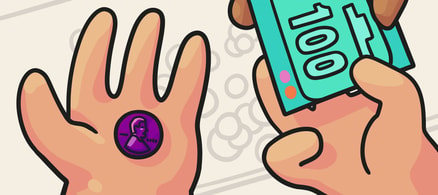1. Reading a map
Maps are large, fragile and frustratingly difficult to fold back up once they’ve been opened to their full size. It makes a lot of sense that few millennials know how to, or even want to use them these days.
In a survey commissioned by British mapping company Ordnance Survey, researchers found that only 20% of millennials wished they were better at reading maps.
They probably should be though, because 60% of millennial respondents say they are reliant on digital maps when going somewhere new and a quarter are very reliant even in their day-to-day lives.
Google Maps and Waze are important tools of 21st century navigation, but there are countless stories of times GPS has failed travelers, causing them to be stranded in desolate locations.
There’s also the question of what happens if your phone runs out of battery or you can’t access online maps.
Reading a physical map can be a little intimidating, but it may be a worthwhile skill to learn and maintain for those in-case-of-emergency situations.
Meet Your Retirement Goals Effortlessly
The road to retirement may seem long, but with WiserAdvisor, you can find a trusted partner to guide you every step of the way
WiserAdvisor matches you with vetted financial advisors that offer personalized advice to help you to make the right choices, invest wisely, and secure the retirement you've always dreamed of. Start planning early, and get your retirement mapped out today.
Get Started2. Driving a stick shift
Pretty soon, no one will understand the saying “that really grinds my gears.”
EPA data says that 35% of U.S. cars that were launched in the 1980 model year had manual transmissions. But, 40 years later, that number has dropped to about 1%.
Data collected by U.S. News and World Report says only 18% of American drivers say they know how to drive stick, and CarMax reports that 96% of Americans drive automatic in their daily lives.
The reasons for stick shifts falling out of favor seem reasonable. First off, the noise a dropped clutch makes is worse than nails on a chalkboard — if you’ve ever heard it, you’ll probably also remember how your stomach dropped at the sound.
Secondly, according to Drive Mag, a little under 20 years ago, the first dual-transmission production vehicle — a 2003 VW Golf — had its maiden voyage, combining the fuel efficiency of a manual with the ease of the automatic.
With electric cars outselling those with manual transmissions in 2019, according to The New York Times, manuals may soon go the way of the dodo — at least in the States.
3. Writing in cursive
It’s hard to get a bead on whether cursive writing is actually going extinct, or if op-ed writers just think it is.
Cursive writing has had an obstacle-filled history over the past few decades. Reuters reports that in 2010, U.S. schools were no longer required to teach it as part of the education system’s Common Core Standards.
Generally, though, it is up to the individual state to decide if it wants to keep cursive writing as a part of its curriculum, and many have chosen to do so.
There is good science behind their decision.
In an article published by the National Library of of Medicine, cursive writing (as opposed to block printing) helps diagnose spatial and graphical learning problems, and helps free up cognitive abilities so that the student can focus on other things, which is what psychology experts call automaticity.
It helps students develop motor skills, learn languages, and can stimulate what Johns Hopkins University calls “true learning” by reinforcing the lessons delivered in other mediums.
That said, the rise of email, digital note-taking and even e-signatures has limited the opportunities to ever show off your fancy penmanship.
Kiss Your Credit Card Debt Goodbye
Having a single loan to pay off makes it easier to manage your payments, and you can often get a better interest rate than what you might be paying on credit cards and car loans.
Fiona is an online marketplace offering personalized loan options based on your unique financial situation.
When you consolidate your debt with a personal loan, you can roll your payments into one monthly installment. Find a lower interest rate and pay down your debt faster today.
Get Started4. Traditional grammar
Unless we’re talking about Latin, language is constantly evolving and therefore, so is grammar.
An article published by Reader’s Digest discusses a few significant changes.
For one, the use of cell phones — with their accompanying emojis and acronyms — has shortened many people’s written communication style. In the same line, as more people communicate over screens, extra letters may be added to certain words to add emphasis: “Mom, it’s fiiiiine.”
Off-screen, the use of more inclusive pronouns and descriptors — such as the gender-neutral they/them — is becoming more and more common. Several grammar authorities including the Associated Press and the Chicago Manual of Style now recognize the singular “they” as the default pronoun over “he.”
In punctuation news, the misuse of the apostrophe — such as “its versus it’s” — has become more common than its proper use; exclamation marks are becoming a common courtesy; and using a period can make or break the tone of your messages.
While this may cause grammar purists to shake their heads in dismay, these “lang-mods” seem to be here to stay.
5. Sewing
If you’ve ever sewn anything by hand, you’ve probably poked yourself with the needle and cursed the thread that won’t push through its eye. The sewing machine, with its bobbins, reverse stitch levers and tension controls, can be even more intimidating.
That’s partly why a 2017 study published by The British Heart Foundation found that 57% of British people said that sewing is becoming a lost art. Half of the participants admitted they need their parents to help them mend something.
Many U.S. schools no longer offer home economics classes (renamed Family and Consumer Services in 1994, according to Business Insider), as boards have generally been following trends to concentrate more on standardized testing rather than hands-on skills.
Still, it is incredibly useful to know how to sew, and since the pandemic, many American millennials have started learning how.
In the past few years, as the destructive qualities of fast fashion have become more public, and more young people are teaching themselves how to sew in order to maintain the style they want in a more sustainable way.
6. Using a landline

Generation Z may never understand the torture of waiting your turn to use the one household phone — which had a tangled up spiral cord that stretched halfway into the next room, if your call required any privacy.
According to data by the U.S. Census, 84% of households had at least one smartphone in 2018, and as of 2020, over 80% of adults ages 25-34 had opted to go entirely wireless, says the National Center for Health Statistics.
Heading out alongside landlines and rotary phones — remember those? — are the days when you needed to remember all your buddies’ phone numbers.
Now that most of us have cell phones that we use for notes, phone numbers and calendars, the phenomenon of “digital amnesia” has grown. Research by multinational cybersecurity company Kaspersky Lab has shown that with a rising reliance on technology, people don’t make an effort to remember these things because they know they have it in the cloud somewhere.
It won’t be long now before the only corded phone you’ll find will be in a museum — but set a reminder now for your trip to see it, so you don’t forget.
7. Using the card catalog
In 2015, the Smithsonian reported that the Online Computer Library Center had discontinued providing the printed cards for those drawers that once lined the walls of most libraries.
The card catalog had been the staple method for organizing a library’s inventory for more than a century. Now, if you see them, chances are it’s in a reference or historical archive department.
The internet, and the proliferation of computers to help people look up the book they want, meant certain death for those little card-filled drawers.
There was just no need to keep them around once online drives could store and organize a library’s collection in a much more efficient and automated way.
Earlier librarians would have to write down long strings of numbers on scraps of paper to find their way to the book they were looking for via the Dewey Decimal System.
This is where that clear, concise handwriting would have come in handy.
8. Balancing a checkbook
Since a lot of purchases and bill payments happen online these days, the frequency of someone writing a check to cover — well, anything — has sharply decreased, especially in the last decade.
The art of balancing a checkbook — that is, going through your own notes of what you paid out to compare it to your monthly bank statement — is also a thing of the past.
While you may not have a physical checkbook anymore, the logic of financial literacy behind this process is sound.
If you’ve ever shut your eyes to whisper a small prayer that your debit card would have enough funds to cover your purchase, maybe taking some time to look at your statements regularly isn’t such a bad idea.
It can help you spend your money more wisely, and it can help you notice any signs of fraud.
Unless you meant to buy thousands of dollars in gift cards. In that case, you do you.
9. Changing your oil
Changing your car’s oil seems a bit daunting, considering that a how-to article by Car and Driver says you need your own car jack, the right kind of oil for your car, and a safe space to be able to get under your car and work.
There’s also the worry that you might do something wrong and hurt your vehicle, costing you more in the long run.
The McNally Institute reports that 74% of men have changed the oil in their car themselves as opposed to 30% of women, although both genders reported regularly checking their levels.
Oil helps keep your engine from overheating, and experts at AAA recommend that, depending on what type of oil you use (synthetic or real) and the kind of car you drive, you change your oil every 5,000 to 7,500 miles.
While it is undoubtedly useful to know how to check when your oil is getting low and perform proper maintenance so your car never runs dry, it might be worth getting a professional to do it in order to free up some time and anxiety.
10. Finding dates in person
You might not have realized it if you’re already partnered, but a large portion of heterosexual couples have found their person on an app, according to a 2019 study from Stanford.
According to sociologist Michael Rosenfeld, 39% of hetersexual couples found their significant other online, growing from 22% in 2009.
Beyond the fact that it’s a multi-billion dollar industry with an effective marketing reach, the initial stigma of meeting someone online has worn off, and people are trusting the technology behind the sites a lot more, says the study.
Another study, this one conducted by Pew Research Group, broke down the difference between different age groups, with 48% of people aged 18-29 saying that they had used a dating app to find someone, with the percentage decreasing the older the demographic.
The study also noted that LGBTQ+ people had higher instances of using apps than people who identified as straight, who are roughly half as likely to use an app.
Consider dating another area of life that technology is streamlining.
11. Ironing your clothes
A lot of people have figured out that their irons do not spark joy and have tossed them to the curb.
Not only are consumers eschewing owning the former household staple, but there are more and more kids who are growing up having never seen an iron at home.
With today’s fashion trends and the ease of laundry services for some, its slow dive into irrelevance makes sense, though.
A lot of clothing is now made with wrinkle-resistant fabric, so that if you fold or hang it once it comes out of the dryer, you should be footloose and fancy-free, at least in that area.
And if somehow they still are a little less smooth than you’d like when it comes time to wear them, most dryers these days come with a wrinkle-free setting: After a couple minutes of that, you should be good to go.
Adding to the mix some anti-wrinkle sprays, the less clunky steamer, and other convenient options, there is really no good reason for bringing ironing back, unless you really like the screech of an ironing board unfolding.
12. Writing letters

Group chats with your best friends, emails with your mom, and sending a quick text have become so common-place that sitting down to write a letter, sealing it in an envelope, finding a stamp, and then going for a short walk to drop it in a mailbox can seem like too much work.
So much work, in fact, that a 2021 CBS News survey reported that 37% of Americans say they haven’t sent a personal letter through the mail in over five years, and 15% have never sent one at all.
This is not something that can be blamed on millennials, as letter writing is a hobby that’s falling out of favor in every age group, but there might be a reason to resuscitate it.
Beyond the fact it simply feels nice to get anything beyond coupons and bills in the mail, there are certain psychological benefits to sending one.
According to research published by Science Direct, expressive writing has been proven to increase resilience to negative emotions and situations, foster a sense of accomplishment, and deepen the connection between sender and recipient.
13. Maintaining a resume
While having an updated resume sure sounds like a good thing, the metrics of job hunting are changing, which affects the influence of a good, old-fashioned curriculum vitae.
In the past, employers have given top priority to an applicant’s experience, so having a chronological compilation of your work history was a good idea. These days, the focus has shifted to an employee’s performance, which is harder to communicate in the traditional format.
In addition, the evolving job market and its constantly changing skills requirements may make the written resume simply too static.
An article by business media brand Fast Company states that 87% of employers look first at a potential hire’s LinkedIn profile, and other than that, there are multimedia platforms like Linktree that can keep a more fluid record of your skills and accomplishments accessible online.
It’s still a good idea to have a resume on hand, but writing your job objective at the top of the page and then trying to remember the last five places you worked might soon become a thing of the past.
14. Driving a car
Whether you buy used or new-off-the-lot, a car can be a costly investment that depreciates the second you drive it home. Then there are the associated costs — insurance, maintenance and gas to keep it running.
The idea of owning a car is falling out of favor mostly in bigger cities, where it is easier to hop on transit, find a carshare or get to your destination on foot.
A study by Wired says that 84% of the United States' 70 largest cities have seen an upward tick in people cycling to work over the last 12 years.
The negative environmental impact is also rubbing people the wrong way about cars, as more people try to use transportation that will lessen the amount of carbon emissions in the atmosphere. With a large number of people generally staying put and working from home during the pandemic, the atmosphere saw a 5.4% decrease in CO2 emissions in 2020, says a paper out of Caltech.
Driving and owning a car isn’t going to disappear anytime soon, but a whisper of its obsolescence is appearing on the horizon.
15. Using a dictionary
Okay, not the dictionary in general, but the physical incarnation of one.
Paper dictionaries are, by definition, huge, expensive to print and the only way to update them is to issue another edition.
Meanwhile, online dictionaries don’t take up any physical space and can grow fluidly to accommodate the changing lexicon of the times.
While you may have inherited a physical dictionary from a relative, chances are (first of all, that that copy is out of date), and that you usually bypass the tome and just Google whatever word you need to know.
There are still benefits to having a physical copy, as noted by children’s book publisher Scholastic.
First, flipping through a book to look up a word teaches you alphabetical order, which is both useful for children and for people learning a new language. You also learn more words than just the one you wanted to look up that way.
It also encourages focus and slows the student down, which can help them digest information.
Regardless of the advantages of a print dictionary, chances are you’re seeing less and less of them.
16. Using a compass
A compass is an incredibly useful, pocket-sized tool. It requires no batteries, and can be used either with a map or on its own. However, these days it is typically only found in the kit bags of outdoors enthusiasts.
Knowing how to use a compass is ideal for those times when you’re taking a trip and your phone runs out of battery, or when you’re traveling in an area you don’t know well.
One important thing to know is that compasses are magnetic, which means its arrow always points to magnetic north — this is different from true north. Once you know how to follow its guidance, a compass can provide consistent information regarding the land you’re on and the direction you’re going.
Your phone does have a compass as one of its features, but you’ll still need to know how to read it. Like reading a map, this list item falls into the “good to have in your back pocket for emergencies” category.
More: 15 things boomers love that are making a comeback
Sponsored
Follow These Steps if you Want to Retire Early
Secure your financial future with a tailored plan to maximize investments, navigate taxes, and retire comfortably.
Zoe Financial is an online platform that can match you with a network of vetted fiduciary advisors who are evaluated based on their credentials, education, experience, and pricing. The best part? - there is no fee to find an advisor.







